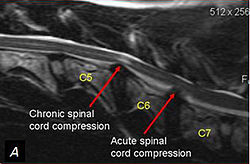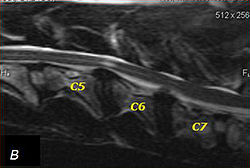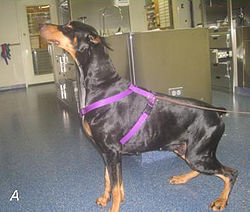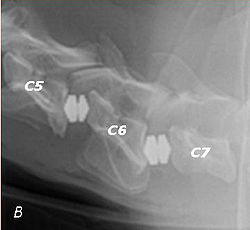- Wobbler disease
-
Wobbler disease is a condition of the cervical vertebrae that causes an unsteady (wobbly) gait and weakness in dogs and horses. The term wobbler disease refers to a number of different conditions of the cervical (neck) spinal column that all cause similar symptoms. These conditions may include malformation of the vertebrae, intervertebral disc protrusion, and disease of the interspinal ligaments, ligamenta flava, and articular facets of the vertebrae.[1] Wobbler disease is also known as cervical vertebral instability, cervical spondylomyelopathy (CSM), and cervical vertebral malformation (CVM). In dogs, the disease is most common in large breeds, especially Great Danes and Dobermanns. In horses, it is not linked to a particular breed, though it is most often seen in tall race-bred horses. It is most likely inherited in dogs, it may be hereditary to some extent in horses.
Contents
Wobbler disease in dogs
Wobbler disease is probably inherited in the Borzoi, Great Dane, Doberman, and Basset Hound.[2] Instability of the vertebrae of the neck (usually the caudal neck) causes spinal cord compression. In younger dogs such as Great Danes less than two years of age, wobbler disease is caused by stenosis (narrowing) of the vertebral canal.[3] This narrowing of the canal is related to degeneration of the dorsal articular facets and subsequent thickening of the associated joint capsules and ligaments.[1] A high protein diet may contribute to its development.[4] In middle aged and older dogs such as Dobermans, intervertebral disc disease leads to bulging of the disc or herniation of the disc contents, and the spinal cord is compressed.[3] In Great Danes the C4 to C6 vertebrae are most commonly affected; in Dobermans it is the C5 to C7 vertebrae.[5]
The disease tends to be gradually progressive. Symptoms such as weakness, ataxia, and dragging of the toes start in the rear legs. Dogs often have a crouching stance with a downward flexed neck. The disease progresses to the front legs, but the symptoms are less severe. Neck pain is sometimes seen. Symptoms are usually gradual in onset but may progress rapidly following trauma.[6] X-rays may show malaligned vertebrae and narrow disk spaces, but it is not as effective as a myelogram, which reveals stenosis of the vertebral canal. MRI has been shown to be more effective at showing the location, nature, and severity of spinal cord compression than a myelogram.[7] Treatment is either medical to control the symptoms, usually with corticosteroids and cage rest, or surgical to correct the spinal cord compression. The prognosis is guarded in either case. Surgery may fully correct the problem, but it is technically difficult and relapses may occur. Types of surgery include ventral decompression of the spinal cord (ventral slot technique), dorsal decompression, and vertebral stabilization.[8] One study showed no significant advantage to any of the common spinal cord decompression procedures.[9] Another study showed that electroacupuncture may be a successful treatment for Wobbler disease.[10]
Commonly affected dog breeds
- Great Dane
- Doberman
- St. Bernard
- Weimaraner
- German Shepherd Dog
- Boxer
- Basset Hound
- Rhodesian Ridgeback
- Dalmatian
- Samoyed
- Old English Sheepdog
- Bull Mastiff[4]
- Newfoundland
- Greyhound
A Recent Update in the Treatment of Wobbler's Disease in Canines
Prognosis for dogs with Wobbler's Disease has been recently changed and it is no longer poor. A new surgical treatment is now available for dogs with Disc-Associated Wobbler's Syndrome. This surgical treatment involves implanting an artificial disc (cervical arthroplasty) in place of the affected disc space. This is a less invasive technique with minimal risks and post-operative care. All dogs treated have displayed excellent short and long terms clinical results. Cervical arthroplasty can also be applied in multiple spaces and it is cost effective. For further reading on the new procedure, please see "Cervical Arthroplasty in Two Dogs with Disc Associated Cervical Spondylomyelopathy." JAVMA, Vol 239, No 6, September 15, 2011, http://www.scribd.com/doc/56257403/DrAdamoFullArticle.
T2 weighted MRI in neutral (A) and linear traction (B) of a 7 year old Doberman with a 2 year history of cervical pain treated with NSAID and presented acutely tretraplegic. A C6-C7 and C5-C6 traction responsive myelopathy are evident on MRI. The spinal cord hyperintensity seen at the C5-C6 is suggestive of chronic lesion and most likely responsible for the chronic history of cervical pain, while the C5-C6 lesion was most likely responsible for the acute tetraplegia.
Same dog (A) treated with double implant (B) three days post-surgery. The dog became ambulatory 3 days after surgery. Four weeks post-surgery had ataxia without conscious proprioceptive deficits, and 3 months post-surgery he was neurologically normal. Owner reported that it was 2 years since the dog was not able to hold the neck in elevated position.
Wobbler disease in horses
Wobbler disease is also found in horses, where it is often called Wobbler's Syndrome, refers to several conditions beyond those listed above, including equine wobbles anemia. It is also used as a catchall phrase within the horse community to designate a neurological problem that has no more specific diagnosis. Some forms, such as cervical vertebral malformation (CVM), are not thought to be hereditary, but rather a congenital condition or a growth disorder. Other forms, such as Equine wobbles anemia, are concentrated in certain breeds and may be hereditary to some extent. Horses with wobbler disease often exhibit ataxia (implying dysfunction of parts of the nervous system), show weakness in the hindquarters, or may knuckle over in their fetlocks, particularly in the rear. With advanced stages of the disease they are prone to falling. While some cases are successfully treated with nutritional and medical management, surgery is also used. One method is the use of Titanium baskets, placed to fuse the vertebrae, thereby preventing compression of the spinal cord. Some horses are able to return to work, with a few able to reach competitive levels. There is currently no complete "cure" for the condition.
Because wobbler's is the best known of the neurological conditions that affect horses, other, unrelated conditions, such as Equine Protozoal Myeloencephalitis and cerebellar abiotrophy are sometimes misdiagnosed as wobbler's, even though the causes and symptoms differ.
Commonly affected horse breeds
References
- ^ a b Bagley, Rodney S. (2006). "Acute Spinal Disease" (PDF). Proceedings of the North American Veterinary Conference. http://www.ivis.org/proceedings/navc/2006/SAE/247.pdf?LA=1. Retrieved 2007-02-19.
- ^ "Spinal Cord Disorders: Small Animals". The Merck Veterinary Manual. 2006. http://www.merckvetmanual.com/mvm/index.jsp?cfile=htm/bc/100416.htm. Retrieved 2007-02-19.
- ^ a b Chrisman, Cheryl; Clemmons, Roger; Mariani, Christopher; Platt, Simon (2003). Neurology for the Small Animal Practitioner (1st ed.). Teton New Media. ISBN 1-893441-82-2.
- ^ a b Ettinger, Stephen J.;Feldman, Edward C. (1995). Textbook of Veterinary Internal Medicine (4th ed.). W.B. Saunders Company. ISBN 0-7216-6795-3.
- ^ Danourdis, Anastassios M. (2004). "The Diagnostic and Therapeutic Approach to Cervical Spondylomyelopathy". Proceedings of the 29th World Congress of the World Small Animal Veterinary Association. http://www.vin.com/proceedings/Proceedings.plx?CID=WSAVA2004&PID=8736&O=Generic. Retrieved 2007-02-19.
- ^ Braund, K.G. (2003). "Degenerative and Compressive Structural Disorders". Braund's Clinical Neurology in Small Animals: Localization, Diagnosis and Treatment. http://www.ivis.org/advances/Vite/braund17/chapter_frm.asp?LA=1. Retrieved 2007-02-19.
- ^ da Costa R, Parent J, Dobson H, Holmberg D, Partlow G (2006). "Comparison of magnetic resonance imaging and myelography in 18 Doberman pinscher dogs with cervical spondylomyelopathy". Vet Radiol Ultrasound 47 (6): 523–31. doi:10.1111/j.1740-8261.2006.00180.x. PMID 17153059.
- ^ Wheeler, Simon J. (2004). "Update on Spinal Surgery I: Cervical Spine". Proceedings of the 29th World Congress of the World Small Animal Veterinary Association. http://www.vin.com/proceedings/Proceedings.plx?CID=WSAVA2004&PID=8698&Category=1264&O=Generic. Retrieved 2007-02-19.
- ^ Jeffery N, McKee W (2001). "Surgery for disc-associated wobbler syndrome in the dog--an examination of the controversy". J Small Anim Pract 42 (12): 574–81. doi:10.1111/j.1748-5827.2001.tb06032.x. PMID 11791771.
- ^ Sumano H, Bermudez E, Obregon K (2000). "Treatment of wobbler syndrome in dogs with electroacupuncture". Dtsch Tierarztl Wochenschr 107 (6): 231–5. PMID 10916938.
Categories:- Dog diseases
- Horse diseases
Wikimedia Foundation. 2010.





